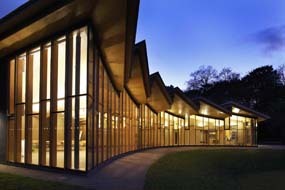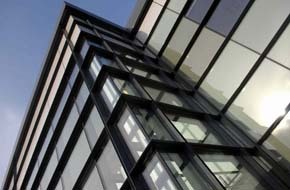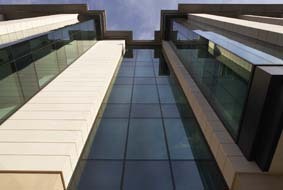01 December 2011
How to get an Image to Speak a Thousand Words!
In this article, Joanne Bridges, Director of construction marketing specialists, Bridges Communications, offers some practical advice about photography - why is it such an invaluable communications tool and how can you ensure your business benefits from the best possible images?
We have all heard the cliché 'an image speaks a thousand words'..... but it really is so true. However many hours PR specialists like ourselves may spend crafting our prose for brochure copy or press articles, the success of each promotional project will often stand or fall by the quality of the images.
However, stunning photography is also a fantastic investment. There is no 'shelf life' for good images, and the uses are numerous - website, sales team portfolios, presentations, editorial, mailers and brochures to name just a few. And the best images will literally leap off the page or screen, helping to promote your business.
But it can't be that difficult to produce incredible shots can it?
I've lost count of how many times over the years we've heard the suggestion - 'let's not use a professional photographer....so and so is quite good with a camera and it would save us some money'.
But in my view that's a big false economy. If it's a building, are permissions in place to actually use shots of that project? Are the file sizes of publication quality? Are the images really the best we can get? Sub-standard images will quite simply damage your reputation.
So what advice would we give for commissioning and using photography? Here are our top 13 tips!
- Be selective. There is always the temptation to photograph every key project. However, we would always advise that less is more. Unless you have a limitless budget, it's much better to invest time and resources in achieving stunning photography of three projects, than mediocre shots of 10.
- Do your research. If you have a building to photograph, find out who owns it and ask their permission. There's nothing worse than having to pay a photographer for a day's shoot and travelling costs, for him to be turned away on arrival by an eager security guard. And it's no surprise how co-operative people become if you offer them a free set of professionally-taken images for their own use!
- Do you want people on the shots? These can really bring a building or a production facility to life. There is nothing more dull than a shot of an empty room. Again make sure the necessary permissions are all in place beforehand. And if you want children to appear on the shots, remember you will need to obtain permissions from parents.
- When will the sun be on the building? Find out the orientation of the main elevation so the photographer can time his visit for the best possible light conditions. This will avoid your products having to be shot in shadow and losing the detail.
- Be patient! For external shots, the weather is absolutely critical. Even the most stunning, award-winning building will look dull and uninteresting on a wet, grey day. All architectural photography should be weather dependent to get the best possible images. This is a major challenge in the winter months so you'll need to find a photographer who is prepared to be flexible, patient and keep a close eye on the forecast for you!
- Consider dusk shots. Dusk shots can be very helpful in overcoming poor weather conditions and can generate some great shots. Just be aware that for the best effect, the lights need to be turned on in the building and the shots shouldn't be taken too late or the roof line will just disappear into the night sky.
- Use a specialist. Depending on your business, you or your agency may need to have several photographers on your books with different specialisms. A really good architectural photographer may not have access to a studio, lighting equipment or have the skills required for product shots. And an expert people photographer might have the fantastic people skills necessary for location work but not have the specialist camera lenses needed for technically correct architectural shots.
- Put together a thorough brief. Photography is very subjective so be really clear about what you want photographing and the type of shots you have in mind. If the shots are to illustrate a press release or brochure, give the photographer a copy of the text. If there are any key features of the product, such as slim sight lines, include that in the brief too. These points may be obvious to you, but a photographer will not necessarily be that familiar with your products or services. Include the location address in full, timing, contact numbers, as well as any permissions obtained - the less the photographer has to find out or assume, the more he can focus on getting the creative elements right.
- Be clear about who owns copyright. A photographer will automatically retain copyright of the images taken. Will he require a credit wherever the shots are reproduced? As this can be difficult to enforce or remember, it may be worth paying an additional fee for the photographer to relinquish copyright to you on completion of the shoot. Be aware that some photographers will charge you for the shoot - and then again for you to actually receive and use your preferred images so be clear about exactly what your commission does and doesn't include.
- If budgets are tight, consider cost-sharing. If you are a fabricator or installer, for example, consider approaching the systems company, architect or main contractor as they will always have a need for good images and may be in a position to share the costs.
- Use your photography to thank the team. Sadly too few businesses take the time to say thank you these days. We would always recommend sending a selection of the best images to the project team - the architect, contractor and perhaps the building owner. Good images for their own portfolios will always be welcome and may help them remember your business for the next project.
- Organise your archive. There is nothing worse than having an urgent request for an image taken a few years ago, for you to be completely unable to lay your hands on it. We would recommend asking your photographer to supply the shots on CD as large tiff or jpg files, pre-referenced with the project name. You should then pick out the best images, reduce them in size and save those on your office system, again by project name. The CDs should then be archived. That way you have the larger files for brochures retained on file but have pre-selected the best images which are easy for everyone to access when required, and without using up significant memory on your network.
- Use the images to your advantage. If you are supplying your images to a third party or member of the project team, make sure you politely insist on a credit for your business - assuming you own copyright of course! This is a great way of maximising your investment in the photography and enhancing your company's own profile and reputation going forward.
As with so many aspects of business, investing a little time up front can genuinely reap rewards - and photography is no different. And of course if your time is at a premium, a good PR specialist or agency would be happy to assist in the process!
Images courtesy of Technal



